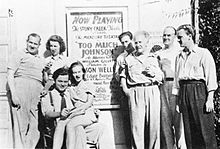
The Mercury Theatre was an independent repertory theatre company founded in New York City in 1937 by Orson Welles and producer John Houseman. The company produced theatrical presentations, radio programs and motion pictures. The Mercury also released promptbooks and phonographic recordings of four Shakespeare works for use in schools.

The Cradle Will Rock is a 1937 play in music by Marc Blitzstein. Originally a part of the Federal Theatre Project, it was directed by Orson Welles and produced by John Houseman. Set in Steeltown, U.S.A., the Brechtian allegory of corruption and corporate greed includes a panoply of social figures. It follows the efforts of Larry Foreman to unionize the town's workers and combat the powerful industrialist Mr. Mister, who controls the town's factory, press, church, and social organization. The piece is almost entirely sung-through, giving it many operatic qualities, although Blitzstein included popular song styles of the time.

Geraldine Mary Fitzgerald was an Irish actress. She received the Daytime Emmy Award as well as nominations for an Academy Award, a Primetime Emmy Award, and a Tony Award. She was a member of the American Theater Hall of Fame and was inducted into the Hollywood Walk of Fame. In 2020, she was listed at number 30 on The Irish Times list of Ireland's greatest film actors.
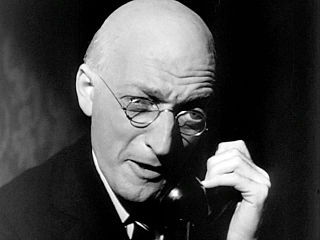
Everett H. Sloane was an American character actor who worked in radio, theatre, films, and television.
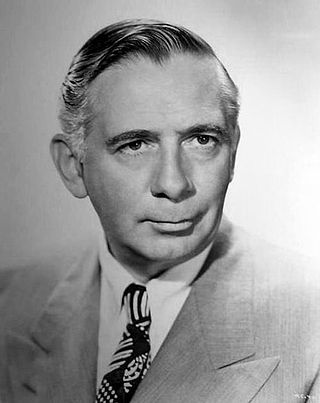
Ray Bidwell Collins was an American character actor in stock and Broadway theatre, radio, films, and television. With 900 stage roles to his credit, he became one of the most successful actors in the developing field of radio drama. A friend and associate of Orson Welles for many years, Collins went to Hollywood with the Mercury Theatre company and made his feature-film debut in Citizen Kane (1941), as Kane's political rival. Collins appeared in more than 75 films and had one of his best-remembered roles on television, as Los Angeles homicide detective Lieutenant Arthur Tragg in the CBS-TV series Perry Mason.

George Alexander Coulouris was an English film and stage actor. He was perhaps best known for his collaborations with Orson Welles, most notably Citizen Kane.
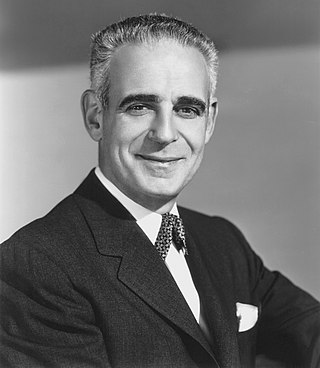
Paul Stewart was an American character actor, director and producer who worked in theatre, radio, films and television. He frequently portrayed cynical and sinister characters throughout his career.

Jane Eyre is a 1943 American film adaptation of Charlotte Brontë's 1847 novel of the same name, released by 20th Century Fox. It was directed by Robert Stevenson and produced by the uncredited Kenneth Macgowan and Orson Welles; Welles also stars in the film as Edward Rochester, with Joan Fontaine playing the title character.

Rose McClendon was a leading African-American Broadway actress of the 1920s. A founder of the Negro People's Theatre, she guided the creation of the Federal Theatre Project's African American theatre units nationwide and briefly co-directed the New York Negro Theater Unit.
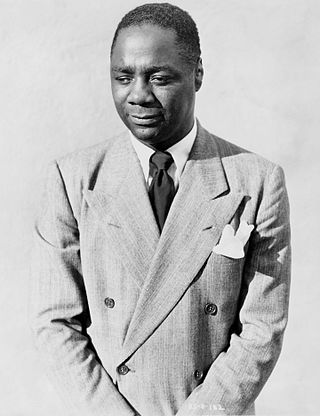
Leonard Lionel Cornelius Canegata, known professionally as Canada Lee, was an American professional boxer and actor who pioneered roles for African Americans. After careers as a jockey, boxer and musician, he became an actor in the Federal Theatre Project, including the 1936 production of Macbeth adapted and directed by Orson Welles. Lee later starred in Welles's original Broadway production of Native Son (1941). A champion of civil rights in the 1930s and 1940s, Lee was blacklisted and died shortly before he was scheduled to appear before the House Un-American Activities Committee. He advanced the African-American tradition in theatre pioneered by such actors as Paul Robeson. Lee was the father of actor Carl Lee.

Arthur John Miles Anderson was an American actor of radio, film, television, and stage.

Norman Nathan Lloyd was an American actor, producer, director, and centenarian with a career in entertainment spanning nearly a century. He worked in every major facet of the industry, including theatre, radio, television, and film, with a career that started in 1923. Lloyd's final film, Trainwreck, was released in 2015, after he turned 100. Lloyd remains the longest-lived male actor from Classic Hollywood.
Stefan Artur Schnabel was a German-American actor who worked in theatre, radio, films and television. After moving to the United States in 1937 he became one of the original members of Orson Welles's Mercury Theatre repertory company. He portrayed Dr. Stephen Jackson on the CBS daytime TV series The Guiding Light for 17 years.

Jack Carter was an American actor. He is known for creating the role of Crown in the original Broadway production of Porgy (1927), and for starring in Orson Welles' stage productions, including Macbeth (1936) and Doctor Faustus (1937). He appeared in a few motion pictures in the 1930s and 1940s.

Native Son is a 1941 Broadway drama written by Paul Green and Richard Wright based on Wright's novel Native Son. It was produced by Orson Welles and John Houseman with Bern Bernard as associate producer and directed by Welles with scenic design by John Morcom. It ran for 114 performances from March 24, 1941 to June 28, 1941 at the St. James Theatre.

Porgy: A Play in Four Acts is a play by Dorothy Heyward and DuBose Heyward, adapted from the short novel by DuBose Heyward. It was first produced by the Theatre Guild and presented October 10, 1927 – August 1928 at the Guild Theatre in New York City. Featuring a cast of African Americans at the insistence of its authors—a decision unusual for its time—the original production starred Frank Wilson, Evelyn Ellis, Jack Carter, and Rose McClendon. Porgy marked the Broadway directing debut of Rouben Mamoulian. The play ran a total of 55 weeks in New York, and the original cast toured the United States twice and performed for 11 consecutive weeks in London.

This is a comprehensive listing of the theatre work of Orson Welles.
There isn't one person, I suppose, in a million, who knows that I was ever in the theatre.
The Comedy Theatre was a Broadway theatre located at 110 West 41st Street in Manhattan that opened in 1909. It presented the first Broadway appearances of Katharine Cornell and Ruth Draper, as well as Eugene O'Neill's first Broadway play. Shuttered in the wake of the Depression, it reopened in 1937 as the Mercury Theatre — the venue for Orson Welles's groundbreaking adaptation of Shakespeare's Julius Caesar and other productions for the Mercury Theatre repertory company. In 1939 it began presenting classic Yiddish theatre. The building was demolished in 1942.

Caesar is the title of Orson Welles's innovative 1937 adaptation of William Shakespeare's Julius Caesar, a modern-dress bare-stage production that evoked comparison to contemporary Fascist Italy and Nazi Germany. Considered Welles's highest achievement in the theatre, it premiered November 11, 1937, as the first production of the Mercury Theatre, an independent repertory theatre company that presented an acclaimed series of productions on Broadway through 1941.
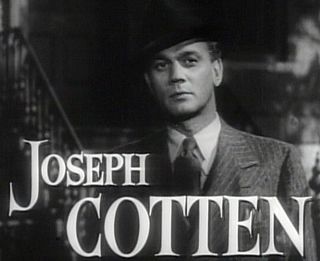
Joseph Cotten was an American actor known for his roles on stage and screen. Cotten's most notable projects include his collaborations with Orson Welles. He portrayed Jed Leland in Citizen Kane (1941), Eugene Morgan in The Magnificent Ambersons (1942), and Howard Graham in Journey into Fear (1943). He continued to act alongside Welles in films such as The Third Man (1949), Othello (1951), Touch of Evil (1958), and F for Fake (1973),


